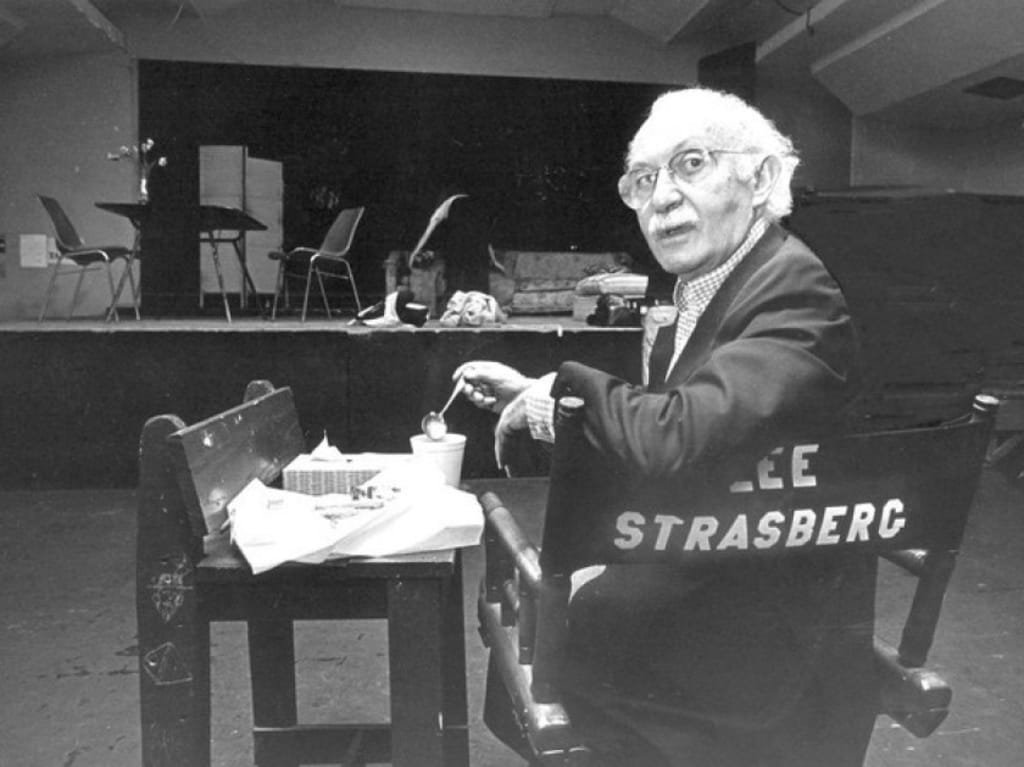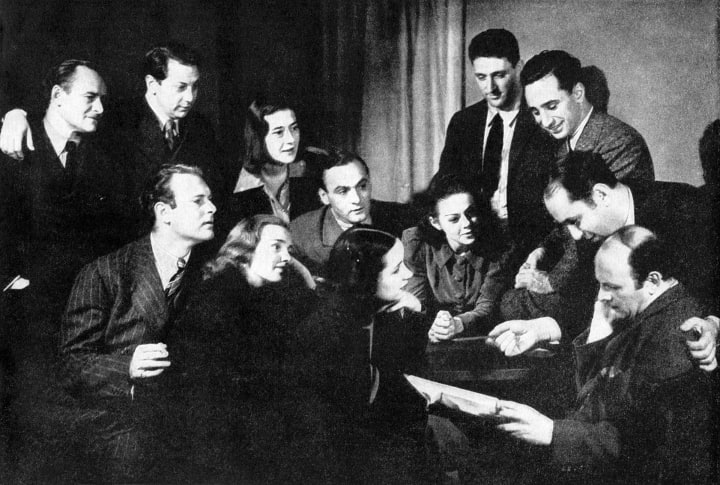The Man & The Method
The Life & Legacy of Lee Strasberg

In this current age of the performing arts industry, there is one man who is most fit to be described as the founder and patriarch of modern American acting. A man by the name of Lee Strasberg. Between 1931 and 1982, Lee Strasberg dedicated his life to teaching several generations of film and stage actors the ideas behind a new acting style, that is now defined as “Method Acting”.

Born in Austria Hungary in 1901, Lee Strasberg was born to a family of Jewish laborers. As economic struggles and anti-semitism increased in Austria Hungary at the turn of the 20th century, Lee’s father immigrated to the United States and found work as a clothes maker; in order to acquire money to both support his family abroad and eventually finance their immigrations. In 1909, the Strasberg family reunited in the Lower East Side of Manhattan in New York City. A neighborhood comprised of dumbbell tenements and occupied by Irish, Jewish, and Italian immigrants. By 1918, the family moved northward to the Bronx, but Strasberg’s older brother, Zalmon, passed away due to the influenza epidemic. Because of his brother’s death, Lee had to quit high school in order to support his family; ultimately finding work as a wig shop, making female hair pieces.


Lee’s life would soon change forever in 1923, when the Moscow Art Theatre (led by Konstantin Stanislavski) arrived in New York for an American tour. Prior to this event, Strasberg never thought much of theatre or acting, but after witnessing the humanism and magnitude of the MAT, he vowed to abandon his life as a laborer and change the face of American theatre with Stanislavsky’s new system. Strasberg met and learned from members of the M.A.T. the essential technique of Stanislavki’s system. The technique of affective memory. The process of embracing moments of an actor’s personal past and using such memories as the catalyst for controllable emotions on the stage.
"The actor does not try to imitate an action or to convey his reactions to the audience. Rather his effort goes toward recapturing the stimuli of the muscular efforts involved in such ordinary acts as putting on shoes and stockings, picking up a cup and saucer, listening to a familiar composition, or tasting a lemon." (Hethmon 99)
"Affective memory is not mere memory. It is memory that involves the actor personally, so that deeply rooted emotional experiences begin to respond. His instrument awakens and he becomes capable of the kind of living on the stage which is essentially reliving." (Hethmon 109)

In 1931, Lee Strasberg was given the opportunity to put Stanislavki’s techniques of affective memory into use. He had met with fellow actors Stella Adler, Robert Lewis, Harold Clurman, Elia Kazan, and Sanford Meisner. Together they would form the Group Theater. With affective memory as the primary tool for displaying emotion on stage, the Group Theater was met with extreme success. It was at this time when the figureheads of this theatre company would become synonymous with a new name for affective memory. What our current society would call “The Method” or “Method Acting”. Yet it did’t take long before The Group Theater found themselves at each other’s throats. It all began when Stella Adler and her younger brother Luther, took a trip abroad to Paris. There, she encountered Konstantin Stanislavski on tour again with the MAT. When she spoke of the tactic and use of affective memory in the Group Theater, Stanislavski became appalled at what they were doing with his system of acting. 5 weeks later, upon Stella Adler’s return to the Group Theater, she insisted that method acting had nothing to do with affective memory. Instead, it is based on controllable emotion through imagination. Such a dichotomy in what method acting truly meant, resulted in the disbanding of the Group Theater in 1941.


It wouldn’t be for another decade, until Lee Strasberg was given a second chance to show the world his theatrical potential. In 1951, he reunited with former Group Theater members Elia Kazan, Cheryl Crawford, Robert Lewis, and Anna Sokolow at the Actor’s Studio; a nonprofit workshop for aspiring actors, seeking work in theater, television, and film. Originally, Strasberg was brought on as a theatre history teacher, but he then became an artistic director, after Elia Kazan relocated to Hollywood with Marlon Brando for the film adaptation of Tennessee Williams stage play, A Streetcar Named Desire. As an artistic director, Lee Strasberg saw the teaching of method acting techniques to several famous actors during the 1950’s and 60’s. Including Paul Newman, James Dean, Al Pacino, Rod Steiger, Dustin Hoffman, Jack Nicholson, Anne Bancroft, Eli Wallach, Montgomery Clift, Robert De Niro, Shelley Winters, Steve McQueen, Robert Duvall, Karl Malden, Gene Wilder, and Noma Jean Baker (AKA: Marylin Monroe). By 1969, Strasberg expand his influence and work by founding his own acting schools in New York and California. Which he entitled the Lee Strasberg Theatre and Film Institute. He would continue to teach acting in New York until his sudden death, by a heart attack, on December 17, 1982.
Strasberg’s personal idea of theatre involved the essential necessities of affective sense memory and concentration, in order to properly execute controllable emotions and delivery during a performance. That you as the actor must embrace and enter the personality and morality of the character that you play. If you don’t do that, then you are not acting. You are merely reciting lines under the conception that you are acting. But since Stella Adler, Elia Kazan, and Konstantin Stanislavski evolved their techniques over time, and Lee Strasberg stuck with he same principles, his personal idea of theatre is somewhat ill-fitting for the stage and more appropriate for film and television. Because unlike theatre, where there are multiple show dates requiring the emotions of the actor to repeated constantly in the same style, film and television can inflict the same emotions in an easier fashion; by means of recording the emotions and actions one time and playing it back to get the same outcome. Because of this “flaw” with Strasberg’s idea of theatre, students were divided about what to make of him. Depending on who you talk to, Lee Strasberg was either a guru-esc. genius who cracked the code behind the necessities of acting, or a cold and tough loving monster who made you feel like you have no idea what it takes to act. And surprisingly, this dichotomy between intelligence and insanity was adopted by others in the entertainment industry. Sam Peckinpah and Phil Spector are primary examples. They are heralded as geniuses for revolutionizing film and music, but are often remembered by those who worked with them as smart asses who were driven by cold emotion, shrewdness, or raw anger as a means of getting the job done.
Yet as time progresses, multiple actors in our current era use method acting and Strasberg’s techniques of affective memory. Including the likes of Christian Bale, (formerly) Daniel Day Lewis, Joaquin Phoenix, Johnny Depp, and Leonardo DiCaprio. Proving that Lee Strasberg’s legacy will not be going away, any time soon, in the world of the performing arts.
Works Cited
- Garfield, David. A Player’s Place: The Story of the Actor’s Studio. Macmillan Publishing Co., Inc. 1980. Print. March 21, 2020.
- Hethmon, H., Robert. Strasberg at The Actors Studio. Theatre Communications Group, Inc. 1991. Print. March 21, 2020.
- Wilmeth, B., Don. Miller, L., Tice. Cambridge Guide to American Theatre. Cambridge University Press. 1993. Print. March 21, 2020.
- Brestoff, Richard. The Great Acting Teachers and Their Methods. Smith and Kraus. 1995. Print. March 21, 2020.
- Hodge, Allison. Twentieth Century Actor Training. Routledge. 2000. Print. March 21, 2020.
- Frome, Shelly. The Actors Studio: A History. McFarland & Company. 2001. Print. March 21, 2020.
- Biography.com Editors. “Lee Strasberg Biography”. The Biography.com. http://www.biography.com/people/lee-strasberg-9496658. Web. March 21, 2020.
- The Editors of Encyclopedia Britannica. “Lee Strasberg: American Actor” Britannica.com. https://www.britannica.com/biography/Lee-Strasberg. Web. March 21, 2020.
- "50-Minute Documentary on LEE STRASBERG: 'The Method Man' (1997)." Youtube, uploaded by Eyes On Cinema, December 20, 2014. www.youtube.com/watch?v=npQm7-GjRQs&t=1762s. Web. March 21, 2020.
- "Lee Strasberg Method Acting." Youtube, uploaded by Amric UG, March 8, 2015, www.youtube.com/watch?v=PPrWqozFkG8&t=191s. Web. March 21, 2020.
About the Creator
Jacob Herr
Born & raised in the American heartland, Jacob Herr graduated from Butler University with a dual degree in theatre & history. He is a rough, tumble, and humble artist, known to write about a little bit of everything.






Comments
There are no comments for this story
Be the first to respond and start the conversation.